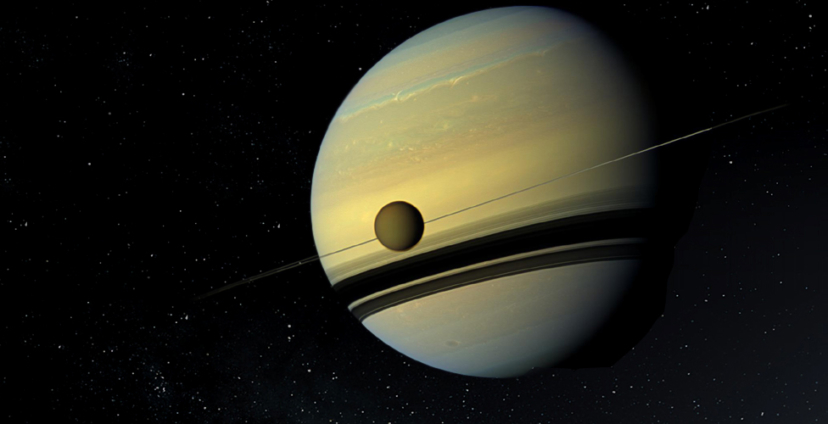NASA is prepping its Dragonfly mission to go look for signs of life on the enticing moon.
Chances are cyclopropenylidene (a combination of carbon and hydrogen) never appeared on your high school chemistry class quizzes, but the molecule has some astronomers buzzing since it was discovered in the atmosphere of Saturn's intriguing moon Titan.
"Scientists say that this simple carbon-based molecule may be a precursor to more complex compounds that could form or feed possible life on Titan," NASA said in a statement Tuesday.
NASA scientists make unexpected discovery of ‘weird’ molecule in Titan’s atmosphere https://t.co/uoFl7hqfRX
— Peek Jar (@PeekJar) October 28, 2020
Titan, an icy moon with methane lakes, is the target of NASA's upcoming Dragonfly mission, which will look for signs of past or present life.
A research team led by NASA scientists published its Titan study in the Astronomical Journal this month.
The team made the discovery thanks to observations from the Atacama Large Millimeter/submillimeter Array (ALMA) in Chile.
NASA planetary scientist Conor Nixon described the findings as "really unexpected."
This is the first time cyclopropenylidene has been found in an atmosphere, though it has been spotted in gas and dust clouds in space.
Titan -- which scientists suspect harbors a subsurface ocean of water -- may be a parallel for ancient Earth.
"We think of Titan as a real-life laboratory where we can see similar chemistry to that of ancient Earth when life was taking hold here," said NASA Goddard astrobiologist Melissa Trainer.
Cyclopropenylidene isn't proof of life on Titan, but it adds a new layer of intrigue to the many mysteries surrounding the fascinating, jumbo-size moon.
Dragonfly, which is essentially a large drone, will be designed to touch down in multiple locations across Titan.
We'll have to wait awhile for clearer answers to what's really going on there. NASA is aiming for a 2027 launch for the mission.
Latest Stories
-
Abuakwa South MP donates GH¢45,200 to support feeding at Kibi School for the Deaf
6 minutes -
‘Just the beginning’ – Finance Minister Ato Forson hails Fitch ratings boost for Ghana
28 minutes -
ALX Ghana event rallies stakeholders to build Africa’s digital future
29 minutes -
Ghana’s inflation to average 15% in 2025 – Fitch
32 minutes -
Telecel leadership pays courtesy calls to new leaders in Ashanti Region
35 minutes -
Ghana’s public debt to fall to 60% in 2025, 2026 – Fitch
35 minutes -
One feared dead, others injured in horrific STC van-tricycle crash in Ho
36 minutes -
Reshaping Africa’s Digital PR Future – Authentic communication with local relevance
46 minutes -
Supreme Court nominee says there is nothing wrong with number of justices on Supreme Court bench
51 minutes -
Payment of nursing trainees’ allowances to be automatic – Mahama
53 minutes -
University of Ghana suspends 14 students, sanctions 97 for exam misconduct
58 minutes -
Personal beliefs must not interfere in rulings on same-sex cases – Supreme Court nominee
60 minutes -
Oil prices fall slightly, but Ghana still at risk as Israel–Iran conflict continues
1 hour -
Justice Sir Dennis Adjei advocates abolition of mandatory death penalty in Ghana
1 hour -
Ghana urges Israel and Iran to de-escalate
1 hour

